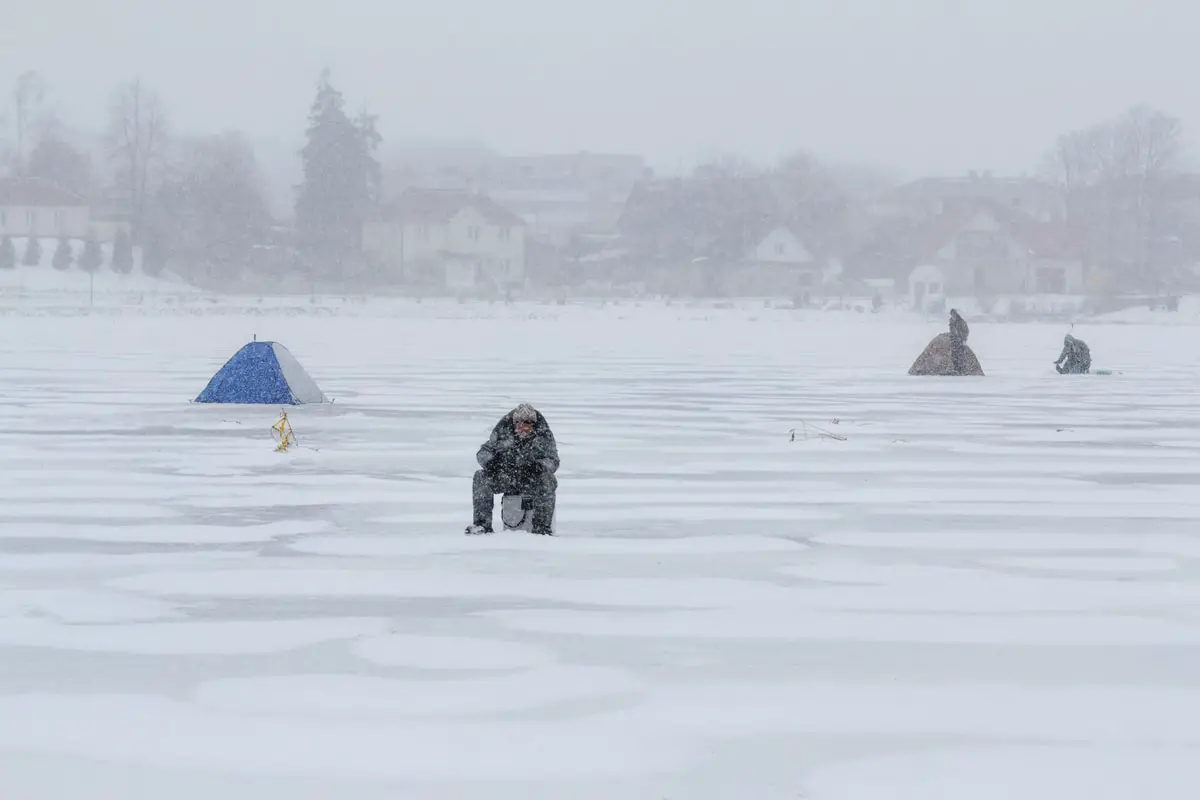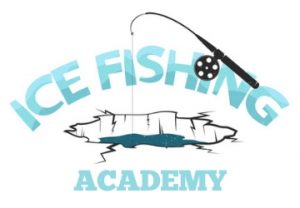If you’re considering ice fishing on a super cold day you’re going to want to read this! When is it too cold to ice fish and where do we draw the line?
When the temperature outside is 18 degrees below zero or lower, it becomes too cold to ice fish outside with exposed skin. With the proper layering of clothing, you can comfortably fish inside a portable ice shelter. At lower temperatures, a portable heater inside the shelter will keep you warm.
Here’s how you can handle those sub-zero temps so you can get out there and catch those fish! And remember, the best way to avoid any problems is to prevent them before you get there!
Our Two Main Concerns When Extreme Cold Ice Fishing
As we all know, ice fishermen are a hardy breed of men and women and reasonably accustomed to colder than average climates! That is why we refer to the best ice fishing areas in the United States as the Ice Belt!
Frostbite and hypothermia are two of the common issues that can affect you when ice fishing! Quite a few people will ignore frostbite and hypothermia symptoms until it’s too late!
Depending on how you are dressed, both frostbite and hypothermia can be avoided with proper preparedness!
Frostbite – Catch it Before It Catches You

Frostbite is damage to the skin and can occur once the temperatures reach the freezing point and any temps below 31F (-0.55C).
When ice fishing the fingers, nose, cheeks, ears, and chin are most susceptible to frostbite since they are exposed the most often. Frostbite can also occur to your fingers while wearing gloves as well!
The first stages of frostbite and indications you may need to warm up or put on additional clothing, especially for the hands and face, are cold skin and a prickly feeling in your skin.
After that, your skin becomes numb, and you may even notice white skin or a mottled appearance on your fingertips, ear, or nose.
I believe we’ve all been on the ice having a good time, and our fingers become cold, so we blow a little warm breath on them to warm them up — and they have a burning feeling!
This is when you must warm your skin up. Because right after that is when your start to become numb and you can no longer tie a new lure or bait onto your line!
We’ve all been there! Even on a nice day, your fingers and gloves become wet, and not long after that, you begin to lose dexterity in your fingers.
One year my fingers became cold on a nasty winter day on the ice so I went back to the truck to warm up. I could barely get my truck keys out of my pants pocket beneath my ice bibs!
It was another five minutes before I could get my hands to work well enough to TURN THE KEY in the lock to open the door!
The Mayo Clinic has a great page if you want to learn more about frostbite.
Definitely keep an eye on your fishing buddies while on the ice!
Hypothermia – Sneaks Up On You
Hypothermia will sneak up on you, so you need to be very aware of hypothermia when you’re on the ice!
Hypothermia occurs when your body loses heat faster than it produces it.
I believe we have all experienced the first stages of hypothermia- shivering! Even on a nice day, once the sun gets low, and temperatures can drop significantly.
There have been times when I was fishing, especially in the late afternoons, where suddenly my body gave a huge shiver! Out of the blue, my shoulders and back would give a quick shake.
Usually, I was getting hungry and becoming a little tired after being outside all day. This shaking or shivering is the first sign of hypothermia.
If you’re out ice fishing, take this shivering as a warning you need to go warm up! Especially if you fish alone like I do a large amount of the time.
The next few hypothermia signs include feeling tired, confusion, slurring your speech, and memory loss.
The concern with hypothermia is it comes on slowly, and you start to make bad decisions. So if you’re fishing by yourself, take the safety precaution and head in or go warm up before you go back outside.
Learn more about hypothermia at the Centers for Disease Control and Prevention (CDC.org).
How to Ice Fish in Extreme Cold Weather
If you want to fish in icy weather, you will need to dress for the cold and be prepared for any weather changes.
Here’s a quick breakdown on what you’ll need for ice fishing when you want to go out in sub-freezing temperatures!
Staying Warm with the Proper Clothing
Right off the bat, you’ll want to be wearing a really warm and protective outer layer.
There are a number of outdoor manufacturers who make quality outdoor jackets and bibs specifically for ice fishing. They are windproof, shed water, insulated, and a number of them also have floatation capabilities!
The debate over “which is best” for ice fishing gear is akin to the Ford vs. Chevy debates! Frabill, Striker, Eskimo, and Cabelas brands all make quality ice gear.
Ever since I began ice fishing, I’ve used gear from Clam Outdoors. Their gear has served me well from the Wyoming mountains to Idaho and across South Dakota!
The Extreme Advantage Parka and Bibs from Clam Outdoors has even kept me on the ice in Canada without having to go into a shelter! Plus, it has a ton of additional features!
If you don’t have ice fishing-specific outerwear and wear something like Carhartt jackets and bibs, they will work fine. Many people don’t want to pay the extra money for another set of ice fishing gear!
Since wind is the main culprit of stealing your body heat, what I like to do when hiking in the mountains, is to carry a lightweight windbreaker! Merely stopping the wind from coming through your jacket will add hours of fishing to your day!
A good quality windbreaker will pack up small and take very little room in your gear. Something like the Columbia Men’s Flashback Windbreaker will work great!
Good gloves and warm, insulated waterproof boots are a must!
I’ve worn a ton of different boots over the years, and the one boot that has met all my requirements is the Muck Arctic Pro. Warm, insulated, waterproof, and has a tight heel cup, so my foot doesn’t slide around and get blisters!
Windbreaks and Ice Shelters
I have two main shelters I like to use. One is a single man flipover and the other is a 6 man thermal popup.
The popup only comes out when I take a friend and his kids ice fishing for the first time, and the flip over is mainly to hauls my gear in when I fish alone.
When I’m wearing the Extreme Advantage Parka and Bibs, I seldom even need to get inside a shelter!
If it’s super cold out and the sun has gone down, I’ll fish inside my flip over. But having an ice shelter can give you a break from standing in a stiff wind. At nights the temps fall fast, so it is nice to have as an option.
Heaters Designed for Cold Weather Ice Fishing
One of the items I carry inside of my flip-over tub is a Mr. Buddy Heater! They run off the small 1lb green propane bottles, and you can also get adapters for a larger 20lb bottle as well.
When I do get inside of my flip-over, I like to be very comfortable! The heater doesn’t add much weight, and it is super nice to have.
You can even warm up food with a Mr. Buddy heater! And if the fishing is really good, but I’m super cold and quite a distance from my truck, having a small heater with you is a blessing!
Stay Hydrated Throughout the Day
Drinking plenty of water is key to having a good day on the ice!
You may not sweat during the winter as you do in the summer, but even though you may not get as thirsty on ice as in the summer, you will lose moisture during the winter as well.
It’s often more difficult to stay hydrated when you’re not as thirsty, so drink water as often as you can when you need it. Drilling holes in the ice, moving your gear from spot to spot will tend to use up your body moisture!
Keep Your Body Fueled
Hypothermia is a condition when you’re losing body heat faster than you can produce it. To produce body heat takes energy and this energy is in the form of calories.
On my way out of town, I’ll stop at a convenience store to pick up a handful of candy bars (I like Snickers!) and a couple of Gatorade bottles or something similar.
It’s a quick energy pick-me-up and keeps my body fueled so it can produce heat. Snacks like nuts or beef jerky are good too!
Overall, I’ve fished in some fairly harsh conditions. And to be honest, the fishing has to be extremely good for me to do so, or I had to drive 20 hours to get somewhere, and I feel like I have to get out there.
I’ll fish in -10 or -15 below zero temps, but it isn’t always fun, especially if there is a good breeze blowing!
Just remember to watch for frostbite and hypothermia, dress appropriately, and have a place or shelter to warm up when you need to!
Have fun and stay safe out there!
